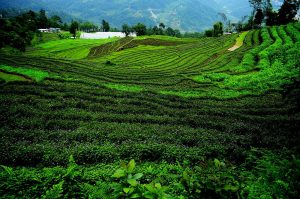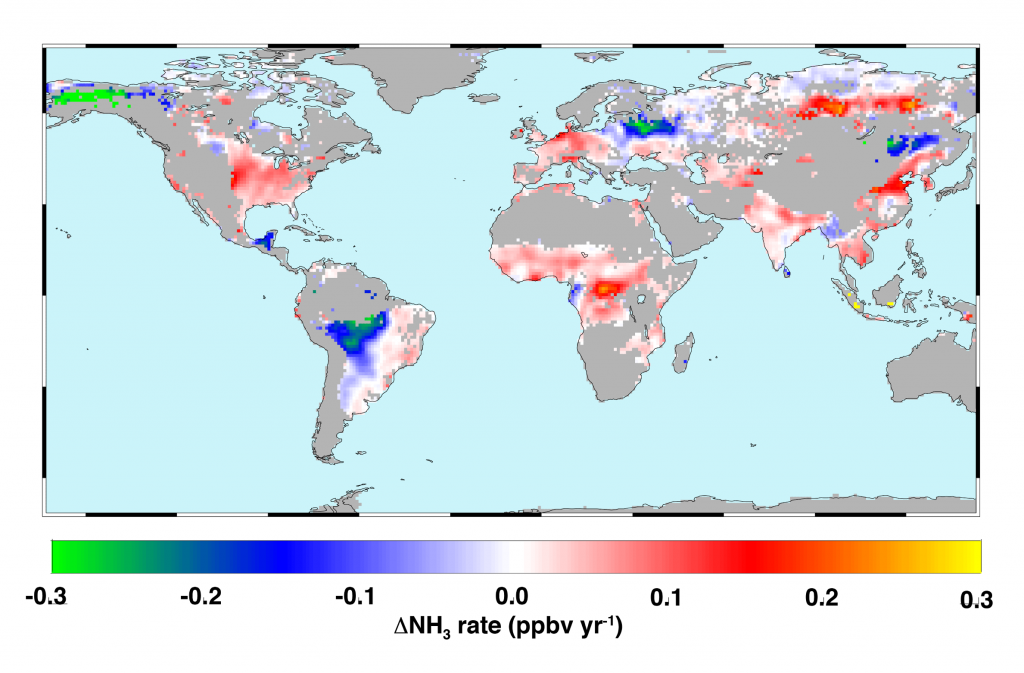In the U.S., efforts to curb acid rain in the 1990s had the unintended effect of increasing ammonia in the atmosphere
16 March 2017

A new study finds hotspots of the airborne ammonia gas over four of the world’s most productive agricultural regions: the United States, Europe, China and India. Increased atmospheric ammonia is linked to poor air and water quality.
Credit: Soumyajit Pramanick, CC BY-SA 2.0 via Wikimedia Commons.
WASHINGTON, DC—The first global, interdecadal satellite study of airborne ammonia gas has revealed “hotspots” of the pollutant over four of the world’s most productive agricultural regions. Using data from NASA’s Atmospheric Infrared Sounder (AIRS) satellite instrument, the research team discovered steadily increasing ammonia concentrations from 2002 to 2016 over agricultural centers in the United States, Europe, China and India. Increased atmospheric ammonia is linked to poor air and water quality.
Although the specifics vary between areas, the increases in ammonia are broadly tied to crop fertilizers, livestock animal wastes, changes to atmospheric chemistry and warming soils that retain less ammonia, according to the new study in Geophysical Research Letters, a journal of the American Geophysical Union. The results could help illuminate strategies to control pollution from ammonia and ammonia byproducts near agricultural areas, according to the authors.
“Our study reports the first global, long-term trends of atmospheric ammonia from space,” said Juying Warner, a researcher in atmospheric and oceanic science at the University of Maryland and lead author of the new study. “Measuring ammonia from the ground is difficult, but the satellite-based method we have developed allows us to track ammonia efficiently and accurately. We hope that our results will help guide better management of ammonia emissions.”
Gaseous ammonia is a natural part of Earth’s nitrogen cycle, but excess ammonia is harmful to plants and reduces air and water quality. In the troposphere—the lowest, densest part of the atmosphere where weather takes place—ammonia reacts with nitric and sulfuric acids to form nitrate-containing particles that contribute to aerosol pollution that is damaging to human health. Ammonia gas can also fall back to Earth and enter lakes, streams and oceans, where it contributes to harmful algal blooms and “dead zones” with dangerously low oxygen levels.
“Here in Maryland, ammonia from the atmosphere contributes as much as a quarter of the nitrogen pollution in the Chesapeake Bay, causing eutrophication and leading to dead zones that make life very difficult for oysters, blue crabs and other wildlife,” said Russell Dickerson, a professor of atmospheric and oceanic science at UMD and co-author of the new study.
Unintended consequences of environmental laws
Each major agricultural region highlighted in the study experienced a slightly different combination of factors that correlate with increased ammonia in the air from 2002 to 2016.
The United States, for example, has not experienced a dramatic increase in fertilizer use or major changes in fertilizer application practices. But Warner, Dickerson and their colleagues found that successful legislation to reduce acid rain in the early 1990s most likely had the unintended effect of increasing gaseous ammonia. The acids that cause acid rain also scrub ammonia gas from the atmosphere, and so the sharp decrease in these acids in the atmosphere is the most plausible explanation for the increase in ammonia over the same time frame.
“The decrease in acid rain is a good thing,” Dickerson said. “Aerosol loading has plummeted—a substantial benefit to us all. But it has also increased gaseous ammonia loading, which we can see from space.”
In India, a broad increase in fertilizer use coupled with large contributions from livestock waste have resulted in the world’s highest concentrations of atmospheric ammonia, according to the study.
The authors suggest efforts to limit sulfur dioxide—a key precursor of sulfuric acid, one of the acids that scrubs ammonia from the atmosphere—could be partly responsible for increased ammonia in China. But China has also greatly expanded agricultural activities since 2002, widening its use of ammonia-containing fertilizers and increasing ammonia emissions from animal waste.
Europe experienced the least dramatic ammonia increase of the four major areas highlighted by the study. The researchers suggest this is due in part to successful limits on ammonia-rich fertilizers and improved practices for treating animal waste.

This map shows global trends in atmospheric ammonia (NH3) as measured from space from 2002 to 2016. Hot colors represent increases due to a combination of increased fertilizer application, reduced scavenging by acid aerosols and climate warming. Cool colors represent decreases due to reduced agricultural burning or fewer wildfires.
Credit: Juying Warner/GRL/AGU.
Balancing demand and protection
In all regions, the researchers attributed some of the increase in atmospheric ammonia to climate change, reflected in warmer air and soil temperatures. Ammonia vaporizes more readily from warmer soil, so as the soils in each region have warmed year by year, their contributions to atmospheric ammonia have also increased since 2002.
“This analysis has provided the first evidence for some processes we suspected were happening in the atmosphere for some time,” Warner said. “We would like to incorporate data from other sources, such as the Joint Polar Satellite System, in future studies to build a clearer picture.”
Warner, Dickerson and their colleagues hope that a better understanding of atmospheric ammonia will help policy makers craft approaches that better balance the high demand for agriculture with the need for environmental protection.
“As the world’s population grows, so does the demand for food—especially meat,” Dickerson said. “This means farmers and ranchers need more fertilizer, which makes it harder to maintain clean air and water. Wise agricultural practices and reduced greenhouse gas emissions can help avoid adverse effects.”
###
The American Geophysical Union is dedicated to advancing the Earth and space sciences for the benefit of humanity through its scholarly publications, conferences, and outreach programs. AGU is a not-for-profit, professional, scientific organization representing 60,000 members in 137 countries. Join the conversation on Facebook, Twitter, YouTube, and our other social media channels.
Notes for Journalists
This research article is open access for 30 days. A PDF copy of the article can be downloaded at the following link: http://onlinelibrary.wiley.com/doi/10.1002/2016GL072305/pdf.
After 30 days, journalists and public information officers (PIOs) of educational and scientific institutions who have registered with AGU can download a PDF copy of the article from the same link.
Journalists and PIOs may also order a copy of the final paper by emailing a request to Lauren Lipuma at [email protected]. Please provide your name, the name of your publication, and your phone number.
Neither the paper nor this press release is under embargo.
“Increased atmospheric ammonia over the world’s major agricultural areas detected from space”
Authors:
Juying Warner, Russell Dickerson, Zigang Wei: Department of Atmospheric and Ocean Science, University of Maryland College Park, College Park, Maryland, U.S.A.;
Larrabee Strow: Department of Physics and Joint Center for Environmental Technology, University of Maryland Baltimore County, Baltimore, Maryland, U.S.A.;
Yuxuan Wang: Department of Earth and Atmospheric Sciences, University of Houston, Houston, Texas, U.S.A.;
Qing Liang: NASA Goddard Space Flight Center, Greenbelt, Maryland, U.S.A., and Universities Space Research Association, GESTAR, Columbia, Maryland, U.S.A.
Contact information for the authors:
Juying Warner: [email protected], +1 (301) 405-2792.
Lauren Lipuma
+1 (202) 777-7396
[email protected]
University of Maryland Contact:
Matthew Wright
+1 (301) 405-9267
[email protected]